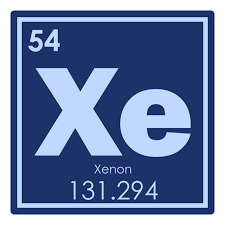Xenon (Xe) is a chemical element that belongs to the noble gases in the periodic table.
Here are some general facts about xenon:
- Atomic number: 54
- Atomic mass: 131.29 g/mol
- Group: 18
- Period: 5
- Electron configuration: [Kr] 5s2 4d10 5p6
- Outer electron shell: 8 electrons
Physical Properties of Xenon
The main physical properties of Xe include the following:
- State of Matter: Xe is a noble gas at standard temperature and pressure. It is colorless, odorless, and tasteless.
- Boiling Point: The boiling point of xenon is -108.13 °C (-162.63 °F), which means that at this temperature, xenon transitions from a gas to a liquid state.
- Melting Point: The melting point of xenon is -111.79 °C (-169.22 °F), which means that at this temperature, xenon transitions from a gaseous state to a liquid state.
- Density: The density of xenon at standard temperature and pressure is approximately 5.894 g/L. Xe is heavier than air.
- Solubility: Xe is sparingly soluble in water and many organic solvents. It exhibits limited solubility in various materials such as fatty substances and polymers.
- Luminescence: Xe can emit bright blue light when subjected to high electrical voltage. This property is utilized in xenon lamps and other light sources.
- Inertness: Xe is chemically inert, meaning it hardly reacts with other substances under normal conditions. It is stable against oxidation, combustion, and chemical reactions.
These physical properties of Xe make it useful in various applications.
Chemical Properties of Xenon
Chemical properties of Xe include:
- Inertness: Xenon is a chemically inert gas, meaning it hardly reacts with other substances under normal conditions, making it stable and safe for many applications.
- Formation of Compounds: Xe can form compounds with other elements, including fluorine, oxygen, chlorine, and others. Xenon compounds, such as xenon fluorides, are important in chemistry and research.
- Luminescence: Xe can emit bright blue light when subjected to electric discharge or laser radiation. This property allows xenon to be used in light sources like xenon lamps.
- Anesthetic Properties: Xe possesses anesthetic properties and is used in medicine as an agent for general anesthesia.
- Applications: Xe is used in lighting sources, laser technology, medicine, scientific research, and other fields that require a chemically stable and non-corrosive gas.
These are some of the main chemical and physical properties of Xe, and it has a wide range of applications in various industries.
Isotopes of Xe
Xe has more than 40 known isotopes, but only a few of them are stable.
Here are some of the most important isotopes of Xe:
- 124Xe: Stable xenon isotope with 54 protons and 70 neutrons. It has a relatively low natural abundance.
- 126Xe: Another stable isotope with 54 protons and 72 neutrons. It also has a low natural abundance.
- 129Xe: This stable isotope has the highest natural abundance. It has 54 protons and 75 neutrons and is important in studies of natural xenon and gas chromatography.
- 131Xe: This is a radioactive xenon isotope that is produced as a result of the decay of radioactive iodine.
- 131Xe is used in medical radioisotope diagnostics and radioisotope therapy.
In addition to these stable isotopes, xenon has numerous radioactive isotopes, such as 133Xe, 135Xe, 137Xe, and many others. These radioactive isotopes are significant in scientific research, nuclear physics, and medicine.
Production of Xe
Xe can be obtained from various sources, including air, natural gas, and nuclear decay processes.
Here are a few methods for obtaining Xe:
- Fractional Distillation of Air: Xe can be obtained by fractional distillation of liquid air. During the process of cooling air to low temperatures (-196 °C or -321 °F), its components, including xenon, are separated through fractional distillation.
- Absorption from Natural Gas: Xe can be extracted from natural gas that contains a small amount of Xe. This can be achieved using special absorbents or membranes that interact with other gas components while Xe is retained or released.
- Nuclear Decay: Xe is produced as a result of the nuclear decay of certain heavy radioactive elements, including radium (Ra) and uranium (U). This process occurs naturally in the Earth’s crust and can be used to obtain Xe in nuclear research.
- Chemical Reactions: Xe can also be obtained through chemical reactions, particularly reactions with fluorine. For example, xenon can form Xe fluorides (XeF2, XeF4, XeF6), which can be released as gases or liquids.
These methods allow for the production of Xe in various purities and concentrations, depending on the requirements and applications.
Applications of Xenon
Xenon (Xe) finds diverse applications in various industries.
Here are some of the primary applications of Xe:
- Lighting Sources: Xenon lamps are used in automotive headlights, projectors, and other lighting sources. Xe light is bright, white, and has high intensity, making it suitable for additional vehicle headlights and large area illumination.
- Medicine: Xe is used as an agent for general anesthesia during surgical procedures. Compared to other anesthetics, xenon is considered safer and has a lesser impact on the respiratory and cardiovascular systems.
- Nuclear Energy: Xe is employed in nuclear reactors as a moderator to slow down neutrons. It has the property of absorbing fast neutrons and converting them into slower ones, facilitating nuclear reactions.
- Electronics: Xenon is used in gas discharge tubes employed in electronic devices such as cameras and laser printers.
- Research and Analytics: Xe is used in scientific research, including nuclear physics, high-energy physics, and planetary atmospheric studies.
Additionally, xenon gas chromatographs are used for the analysis of samples in chemical and biological laboratories.
These are just a few general examples of xenon’s applications. Thanks to its unique physical and chemical properties, Xe has a wide range of uses in numerous fields, including astronomy, laser technology, metrology, and many others.
